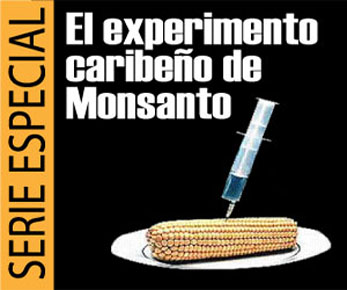Third part of ‘Monsanto’s Caribbean Experiment’

Transgenic corn
American John Francis Queeny was inspired by a Puerto Rican woman to name, in 1901 in Missouri, the Monsanto company, which started as a pharmaceutical. Queeny named the company after his wife Olga, daughter of Emmanuel Mendes de Monsanto, who in turn funded the first steps of the corporation.
This was to become a manufacturer of Agent Orange, the defoliant and herbicide that was tested in Aguadilla farms in the 50’s, and that was used in large scale to strip the jungle that under which the enemy of the United States hid during the Vietnam War.
Today, Monsanto is the largest producer of transgenic seeds in the world, and uses Puerto Rico as a huge laboratory to develop genetically modified corn, soybean, sorghum and cotton. As an agricultural corporation, it occupies more than the 500 acres allowed under the Constitution, whose Article VI was intended to prevent monopoly and the displacement of small local farmers, as happened early last century when the sugarcane empire reigned, which Emmanuel Mendes Monsanto, funded in Vieques and in St. Thomas in the U.S. Virgin Islands.
 Monsanto. Transgenics. Among the scientific community and consumer advocacy groups, those two words incite passions. Some argue that genetically modified seeds can increase food production in places where pests and drought abound, which could alleviate famine in third world countries.
Monsanto. Transgenics. Among the scientific community and consumer advocacy groups, those two words incite passions. Some argue that genetically modified seeds can increase food production in places where pests and drought abound, which could alleviate famine in third world countries.
However, an independent scientific organization in the United States, the Union of Concerned Scientists, dedicated to environmental protection, argues that transgenics do not result in an increase in reliable production and require more pesticide than conventional crops. Consumer groups claim that the impact on human health of transgenics has not been studied in depth and warn that federal laws do not require food manufacturers to state on labels that it contains transgenic components.
In practice, it is known that the pollen of “improved” seeds may, by accident or on purpose, reach crops that are not genetically modified. That means that if Puerto Ricans jumpstart food production and begin to harvest their best land in the south, where there are seed producers, potential corn crops, for example, would be at risk of contamination.
Corporations also may argue that the farmer “stole” the patented genetic material. This happened with the famous case of Canadian canola farmer Percy Schmeiser, whose crops were contaminated in 1997 on his farm in the province of Saskatchewan, and the Supreme Court of Canada decided that it constituted a “use” of the invention patented by Monsanto.
The company makes farmers sign a contract stating that they waive the ancient practice of saving seeds for next year, so they have to go back to buy more. There are not many options: 90% of corn sold in the United States has genetic material produced by Monsanto.
Much of the company’s revenue stems from the fact that it also manufactures the Roundup “total herbicide”, one of the world’s most popular, sold even in department stores gardening sections. The corporation produces the “Roundup Ready” seeds, genetically engineered to resist herbicides so that farmers can apply it to kill all plants except the genetically modified crop. In other words, Monsanto genetically modifies a plant not to increase food production or that it survives plagues, but to resist other agricultural products they sell.
International organization Earth Open Source, that brings together farmers, corporations and academic institutions, argued in a report last June that the herbicide, whose active ingredient is glyphosate, still used at concentrations lower than those applied in agriculture, causes birth defects in laboratory animals. But the information has been withheld since the 80s by European regulators, says the company.
Glyphosate is an herbicide developed for the removal of weeds and shrubs. Plants leaves absorb it, and they die because it removes their ability to generate amino acids necessary for life.
An exception was the courts of France. They found Monsanto guilty of, between 2007 and 2009, falsely marketing this herbicide as “biodegradable.”
And this is part of the company profile that represents the type of investment that the Government of Puerto Rico is encouraging to consolidate the island as a destination for life sciences, according to Economic Development and Commerce Department Secretary José Pérez-Riera. The Puerto Rico Promotion and Development of Agricultural Biotechnology Companies Law, signed in 2009, establishes as public policy to turn the island into a mecca of that agricultural sector.
“Certainly, an industry that experiments on Puerto Rican soil is subject to the requirement of preparing an environmental impact statement required by the Puerto Rico Environmental Public Policy Law,” said attorney Jessica Rodriguez’s, a professor of the InterAmerican University Law School. “Transgenic experimentation affects the health of soils and groundwater, and the chemicals used may also present health risks on the population. Therefore, prior to any government approval be given, an environmental impact statement had to be prepared and had to be made public so that people could learn and participate in the proceedings.” The Environmental Quality Board could not tell the Center for Investigative Journalism if these companies comply with this requirement.
Monsanto itself, meanwhile, acknowledged in the lease contract for Land Authority property in Juana Díaz, that their activities, “may generate material and substances that are toxic, both for humans and the environment in general, if adequate management practices are not carried out.”



Excellent article. So sad that our beautiful island is use for this purpose. Are there any environmental groups involved and trying to make any changes?